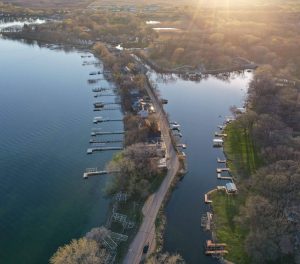Rock River Basin, Iowa — With the predicted rains and snowmelt, Rock Valley City officials continue to be concerned about river flooding this spring, after two floods in five years. Upstream however, Rock Rapids City officials are less concerned.
Rock Valley officials say that they have received an updated river elevation forecast for the Rock River in Rock Valley from the National Weather Service and that it shows that the Rock River will crest between 15.00 to 19.00 feet by midday on Friday. At last report, the Rock River in Rock Valley was at 6.46 feet.
At 19 feet the City hasn’t needed to construct berms to protect properties. River levels above 20 feet require active flood protection measures. Historically, the highest river crest occurred in 2014 at 22.72 feet and in 2018 at 21.30 feet.
City officials say that there are numerous existing conditions that may impact the forecast, which may lead to the National Weather Service to amend their forecast. The City of Rock Valley says they will be closely monitoring the conditions and the forecasts.
Meanwhile, upstream in Rock Rapids, City officials appear to be much less concerned. Rock Rapids Mayor Jason Chase says that City officials are aware of the potential for flooding this spring. He says a fast thaw will increase the risk, but a nice slow thaw will minimize it. Chase says, “We always have plenty of sandbags and supplies at the ready, along with new pumps to help with localized backups and flooding. We also have contacts for other equipment, should the need arise. Unlike Rock Valley, we were able to complete a major mitigation project after the 2014 flood that amounted to over $6 million dollars.”
Mayor Chase says that project removed a majority of the flood-prone housing stock in Rock Rapids, making the town much less susceptible to the flooding problems that Rock Valley had last year. Chase says Rock Rapids’ main concerns will be making sure the sanitary sewer system can keep up with the increased loads brought on by the spring thaw. He says the City will have sand and bags available to those neighborhoods that feel the need to put them out to protect their homes.
Rock Rapids City Administrator Jordan Kordal echoes the Mayor’s sentiments. He says that the City of Rock Rapids has been preparing for the next flood since the last such event.
Kordahl says that after the June 2014 flood, the City used federal and state funding to acquire and demolish 54 residential and two commercial properties and convert those properties into permanent open space. The project was closed out in December 2018, with final payment from FEMA in January 2019.
He says that properties that showed either substantial damage from the 2014 flood and/or significant potential for future exposure to flooding were identified as eligible for the buyout program. Participation in the program was not required. However, in order to encourage voluntary acceptance of the buyout, the City offered pre-flood market values, along with relocation assistance, when applicable.
Kordahl says that the purpose of Hazard Mitigation is not to recover from past disasters, but rather to prepare for future events. Buildings located in the floodplain contribute toward increased flood heights and velocities. Removal of such obstructions helps to reduce the severity of future flooding. It also prevents future damages to these buildings that result from their exposure to flood waters.
According to Kordahl, the primary purpose of the hazard mitigation project was not to provide financial assistance to individuals, but rather to mitigate damages from future disasters by reshaping the floodplain.
He says, “Other benefits include access in times of flood for emergency vehicles; reduction in the cost of providing services during and after flood conditions; and the assurance of continued eligibility for property owners to purchase flood insurance through the National Flood Insurance Program.”












